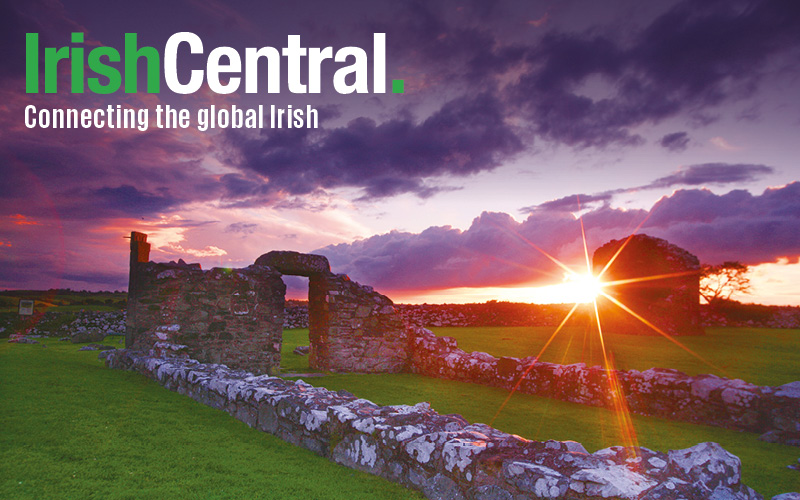The Easter 1916 Irish flag that flew over the GPO during the Easter Rising failed to sell at an auction in New York on Tuesday when it was withdrawn at $400,000, a full $100,000 under its reserve price.
The green, white and yellow-gold Irish Tricolor was initially predicted to fetch up to $700,000, but on Tuesday it was quickly withdrawn when it failed to pass $400,000.
Bloomsbury in New York held the auction in conjunction with Whyte’s, Ireland’s premier auction house for Irish art and collectibles.
The flag was just one of many of the 70 Irish arts and artifacts on offer that did not sell on Tuesday at the auction house in Midtown Manhattan.
The focal point of the auction was the historic Irish Tricolor that flew defiantly over Dublin’s General Post Office (GPO) in the 1916 Rising. The sale attracted many well-heeled bidders to the Bloomsbury Auction House on West 48th Street on Tuesday morning.
But to the surprise of many, the majority of the listed items did not often reach their projected price ranges.
An early precursor to the eventual green, white and orange flag, the GPO flag has a dramatic history worthy of its importance to Irish independence that seemed certain to excite the curiosity and interest of likely bidders both public and private.
Made of Irish linen, the Irish flag measured 29 by 63 inches. Its historic importance was clear to anyone who looked at it.
Although prior to the auction many observers felt assured that representatives of the Irish government would make a bid for the flag to ensure it remained in Irish hands, Ian Whyte, the director of Whyte’s Fine Art Auctioneers who curated the auction, told the Irish Voice he was quite certain the Irish government would not participate.
“The Irish government will not be bidding on the flag, I’m certain of that,” Whyte told the Irish Voice. “At a time when the country is in a deep recession, when civil servants are taking pay cuts and schools are being closed, they cannot be seen to be making a commitment of cash on an item in this price range.”
Bloomsbury’s sale catalogue notes that the flag, which is framed behind glass, is accompanied by a note from Dr. George Saint George (who owned the flag until 1922) reading, “Captured by British Troops at GPO Dublin, April 1916 and given to Dr. George Saint George by an old war veteran, Sergeant Davis.”
The flag is the only recorded full sized Tricolor of the 1916 Rising in existence and of the utmost rarity, as it was captured from the headquarters of the short-lived Irish Republic founded by Patrick Pearse and his Republican comrades, making it an icon of immense significance in the history of the Irish revolution.
But as it turned out the flag failed to achieve its target sale price on the day and was withdrawn from auction.
That does not imply it will not sell within the next few days, however. Bidders who chose to protect their privacy by making their bids by telephone or the internet expressed interest in the historic Irish flag, and representatives at the auction expressed some confidence that it could sell behind the scenes in a private bidding scenario within the next few days.
“In Ireland many people come to property auctions when a house is on the market without making a bidding at the event,” said Whyte. “That may well be the case here too.
“We have interest from a telephone bidder that could lead to a sale. Sometimes these kinds of discussions can lead to an even higher final sale figure.”
The auction is the first of what Bloomsbury hopes will become an annual Irish sale.
Protecting the identity of each bidder is an increasingly common feature of contemporary auctions in the city, so each participant made no secret of their strong interest in discovering who else was in the room. Heads turned to take in each new arrival.
Expensive looking men in striped shirts and bow ties took their seats in rows alongside women who looked like they might own entire city blocks of the Upper East Side.
Englishman Tom Lamb, who was formally the head of book sales at Christies in London for 26 years, curated the auction. Speaking before it commenced he told the Irish Voice, “I’ve always done themed sales in literature, travel, science, and so on, in most fields of book collecting. We plan to host an Irish themed auction annually from now on in the week just following St. Patrick’s Day.
“This is a rich man’s sale, you know. It’s not like we’re selling $100 items. If you’re going to see in this present day market you have to sell quality to make it a success. I don’t think there’s been another sale on the East Coast that’s solely devoted to Irish things on this scale, so we’re rather hoping this is going to be the beginning of our auction house’s annual affair with the Irish community.”
The auction included a treasure trove of Irish arts and artifacts such as a first edition of Mosada, Irish Nobel Prize winning poet W.B. Yeats’ first book, which was listed between $70,000 and $100,000.
Even within his own lifetime Yeats’ debut book was enthusiastically sought after, but on Tuesday morning it failed to reach its projected price range and was withdrawn from sale.
A five page, typed and signed manuscript article by President John F. Kennedy, written while he was briefly employed as a journalist, was also offered for sale. Kennedy’s article, entitled “Eamon de Valera Seeks to Unite All Ireland” was estimated to fetch between $20,000 to $30,000, but it also was withdrawn from auction when it failed to achieve its target price range.
Surprise items like artist Rita Donagh’s 1982 work Single Cell Block boasted a more contemporary Irish political theme, and it quickly sold for it’s initial estimate of $15,000. Donagh’s work dealt with the turbulent political situation in the North during that period.
In all the entire auction began and ended within 45 brisk minutes.




Comments